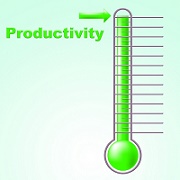 For every business, maximizing the productivity of workers is crucial to success.
For every business, maximizing the productivity of workers is crucial to success.
It’s an incredibly simple concept, but often equally difficult to achieve: How do you motivate employees to achieve more?
From a management perspective, ensuring that every employee is contributing effectively toward goals is one of the most formidable challenges. And there’s no long-term fix. It must be tackled on a continuing basis, because when productivity slips, profits suffer. And when profits suffer, management suffers.
Boosting productivity is the obvious solution, which often requires creative thinking. These three approaches often produce good results:
Communicate, Communicate, Communicate
Effective communication with employees can have tremendous impact on productivity. In day-to-day operations — and especially when uncertainty is the order of the day — employees often don’t have the information they need to work at their most efficient levels.
By the same token, if employees are unclear about priorities and expectations, productivity often suffers, and efforts are expended in the wrong directions. In the worst case scenario, management expectations may be impossible to meet, leading to employee frustration and further reductions in efficiency.
One solution is obvious. Two-way communication between all management levels and employees must be established and maintained. Managers must make expectations and priorities clear to employees — and listen to employees to discover where those expectations exceed capabilities. With clarity and understanding, frustrations are reduced and productivity increases.
Review Workloads, Compensation and Other Incentives
Employees exchange their work for compensation. Ignoring that basic fact often contributes to reduced productivity. If compensation isn’t competitive or if workloads are impossible to meet, employees may respond by reducing their commitment. Especially when productivity is chronically low, adjustments in workloads or pay increases often restores desired levels.
Adding temporary employees to handle short-term workload increases and offering tangible incentives to employees are other effective ways to boost employee productivity. For the long term, though, other adjustments may be required in either compensation or staffing. Through achieving an ideal balance, dramatic improvements are possible.
Showing Respect and Appreciation for Workers Boosts Productivity

Recognizing that employees need to balance work and life outside of work is crucial, too. Involuntary overtime, inflexible time-off policies, and other issues can interfere with this. Making employees feel like valued members of a team effort is a strong incentive for performance. Management training and fresh policies in these areas can have a major impact.
When Productivity Decreases, Creative Management Is Essential
Many factors are often in play when employee productivity takes a downward trend in any business. Correcting such trends often requires taking a fresh look at the relationship between management and employees. Offering rewards and improving communications is far more effective than trying to force employees into productivity increases.
